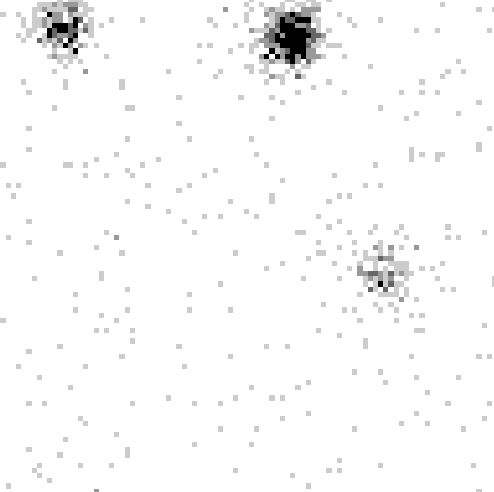

This is the x-ray image.
You may also see images at other wavelengths by clicking on the colorbar at a point above any of the dashed arrows (which point to other regions of the spectrum at which images are available). The solid arrow shows the spectral region you are seeing now. This is not intended to be a linear scale in wavelength, but only a rough guide to the wavelength of the observation.
This group of stars is a small star forming aggregate lying just south of the L1641N group. V380 Ori, the optically brightest object in this group has been recognized for a long time as a member of the Herbig Ae/Be star population (Herbig 1960), a young intermediate mass star. This star is the bright object illuminating the large reflection nebula (NGC 1999). The original H-H objects (Herbig 1951, Haro 1952) are also found in this field. They are the nebulous objects in the lower half of this image. An optical infrared study of this region (Strom et al. 1985) was able to identify the powering source of the outflow, of which HH 1 & 2 are the visible manifestations, as the cm wavelength VLA source discovered by Pravdo et al. (1985). A water maser source, detected by both the VLA and IRAS also lies within this field as do numerous other extremely young objects as shown by the luminosity function derived for the region by Strom, Strom and Merrill in their infrared imaging study of L1641.
This image was made with the ROSAT PSPC (position sensitive proportional counter) detector at soft x-ray wavelengths. The stars visible in this image are V380 Ori (top center), the Cohen-Schwartz star and another star to the east of V380 Ori. X-ray emission from pre-main-sequence stars is generally due to radiation from million degree gas confined in magnetic field loops above the surface of the star. A similar phenomon is seen on the Sun, called coronal loops. The x-ray emission from pre-main-sequence stars is sointense because the radii of pre-main-sequence stars are much larger than that of the Sun, therefore the surface area of these stars is much larger.
If you wish more information about these images, a page is available for your perusal. You may also return to the overview page.
References
Haro, G. 1952, ApJ, 115, 572
Herbig, G. 1951, ApJ, 113, 697
Herbig, G. 1960, ApJ Suppl, 4, 337
Pravdo, S.H. et al. 1985, ApJ Letters, 293, L35
Strom, K.M. et al. 1985, AJ, 90, 2281
Strom, K.M., Strom, S.E. & Merrill, K.M. 1993, ApJ, 412, 233
www@hanksville.org
© 2000